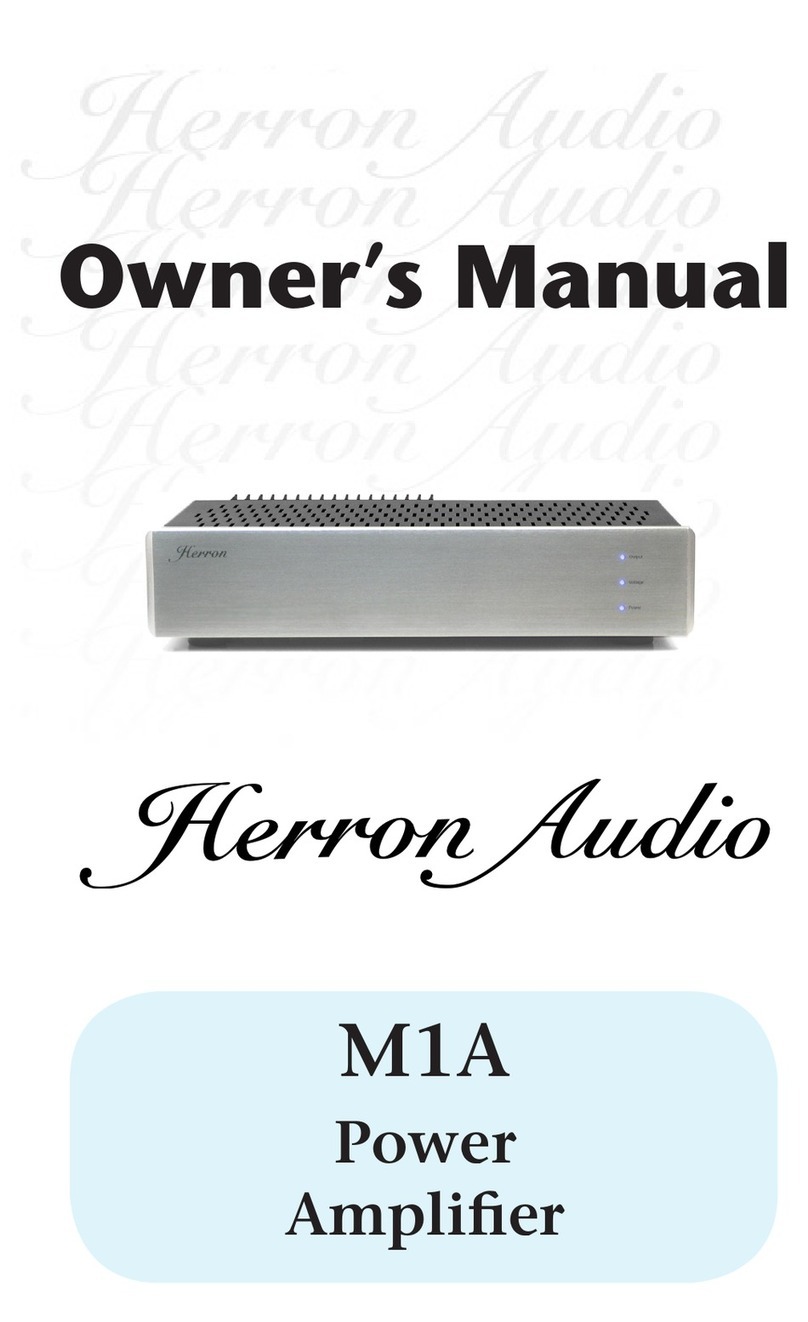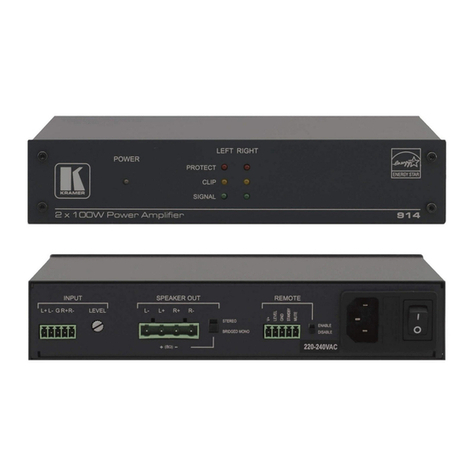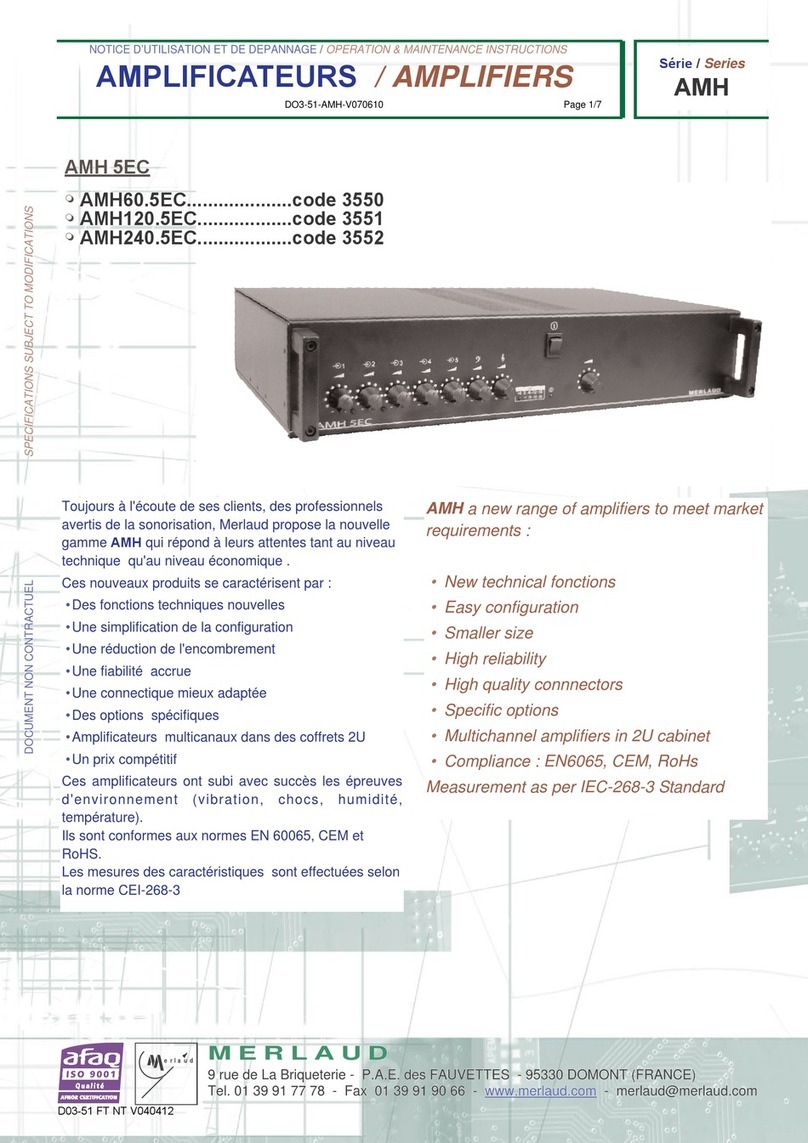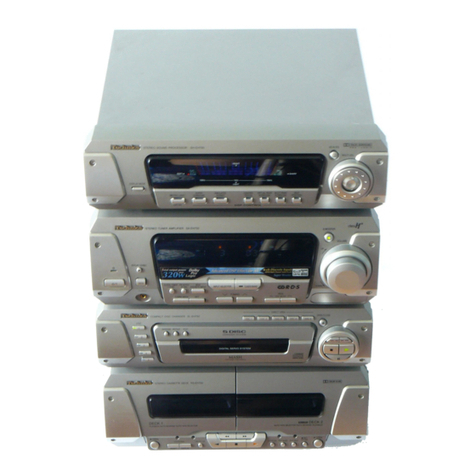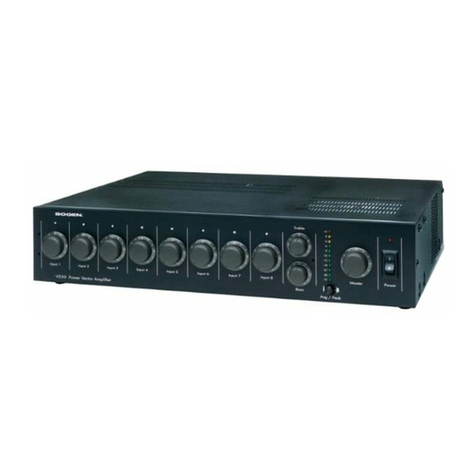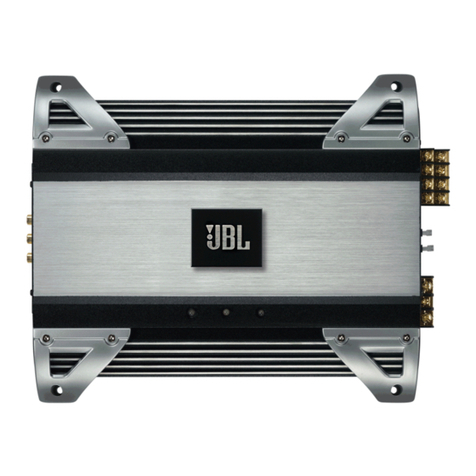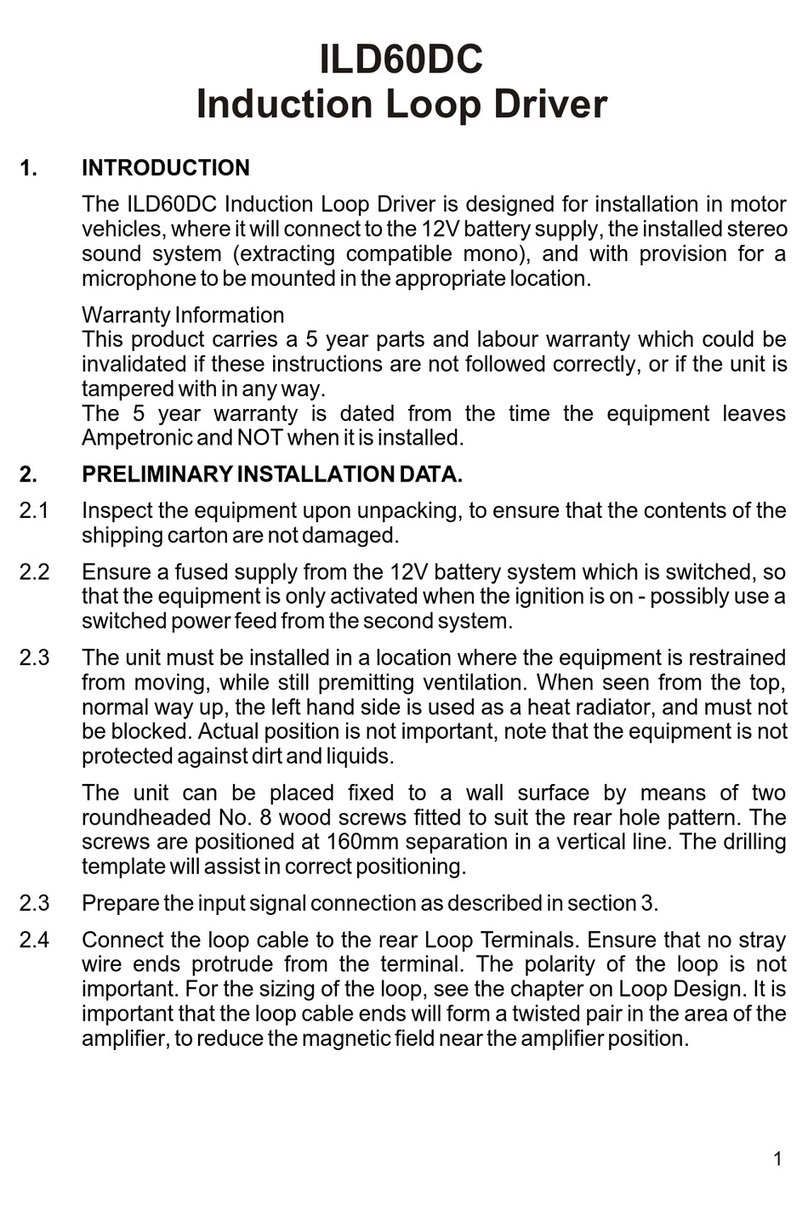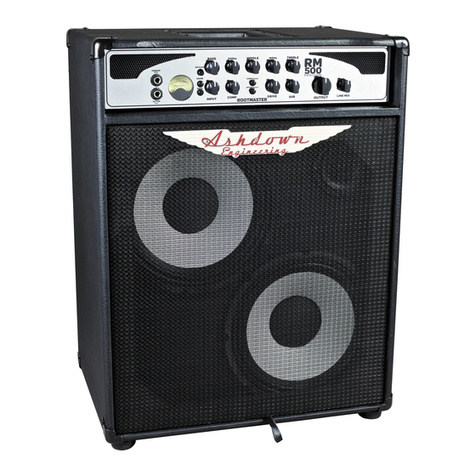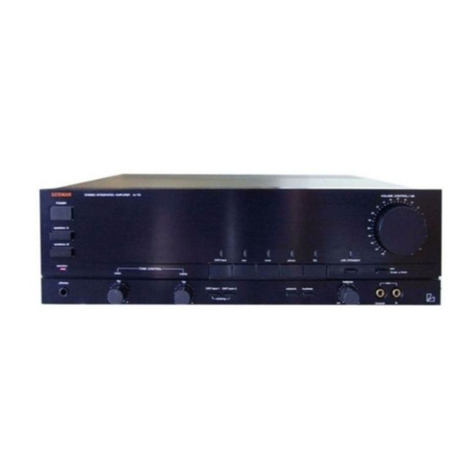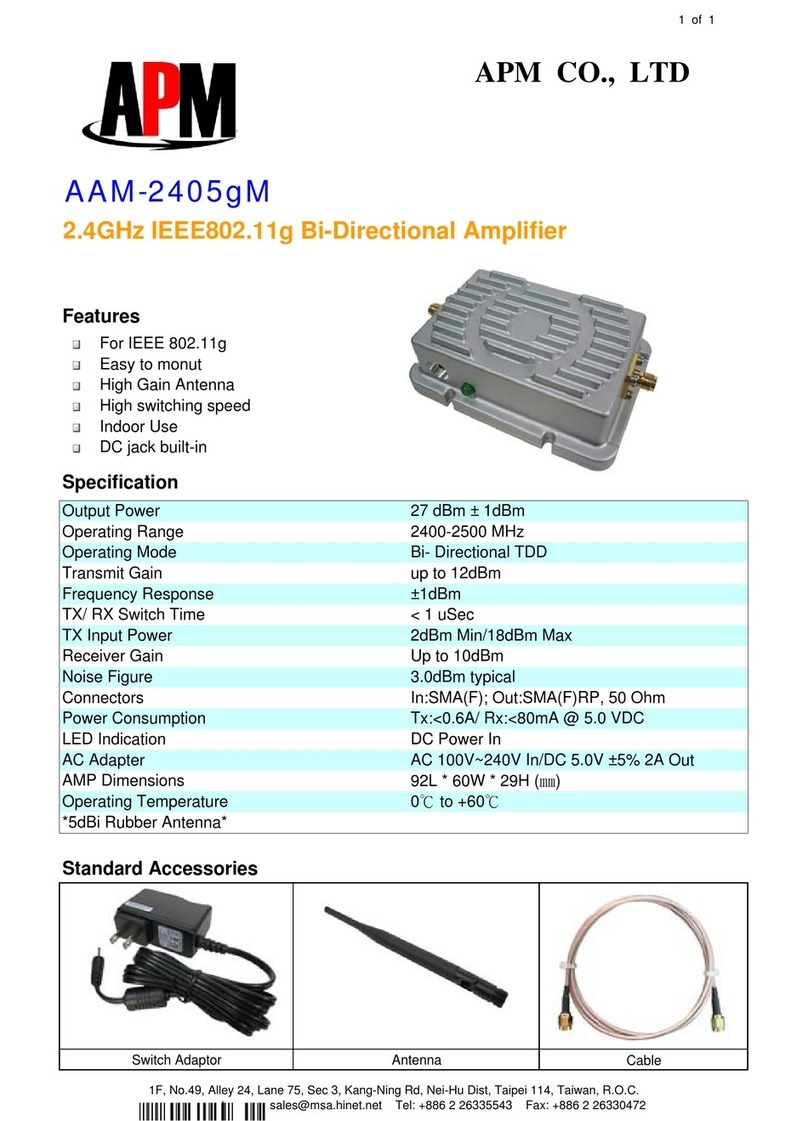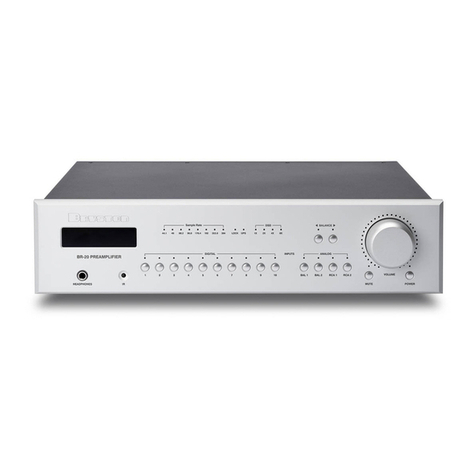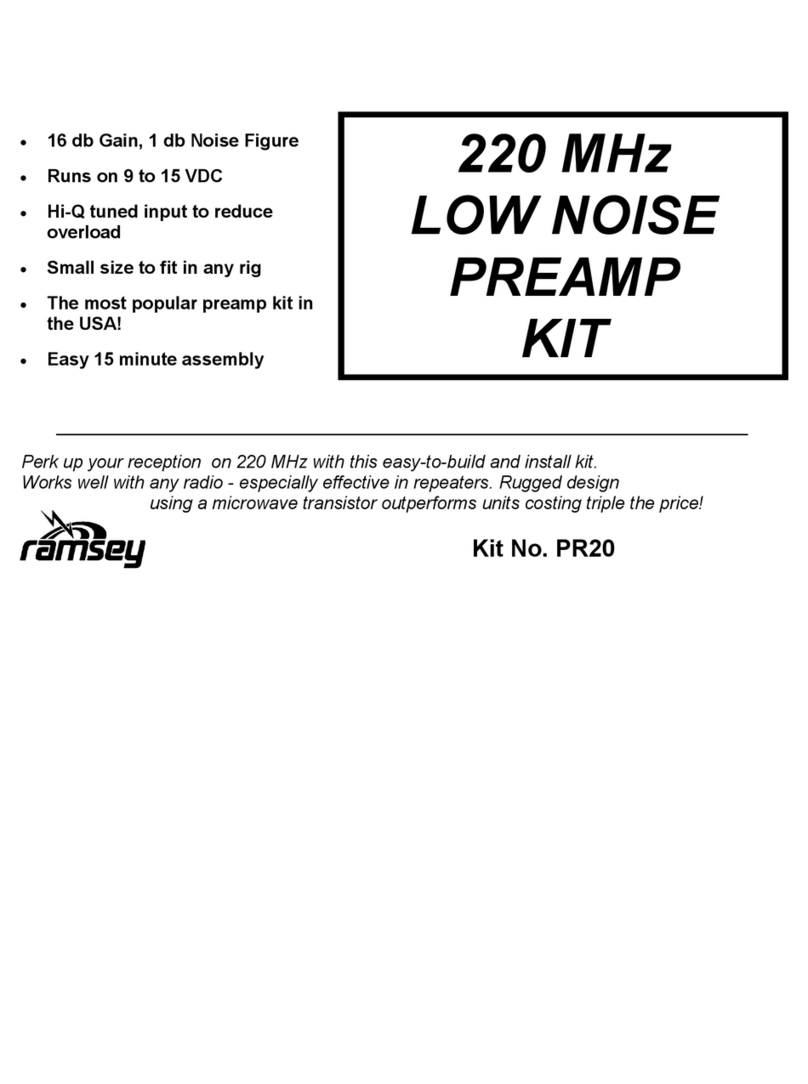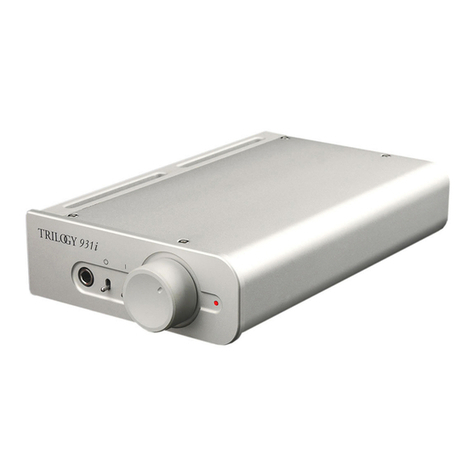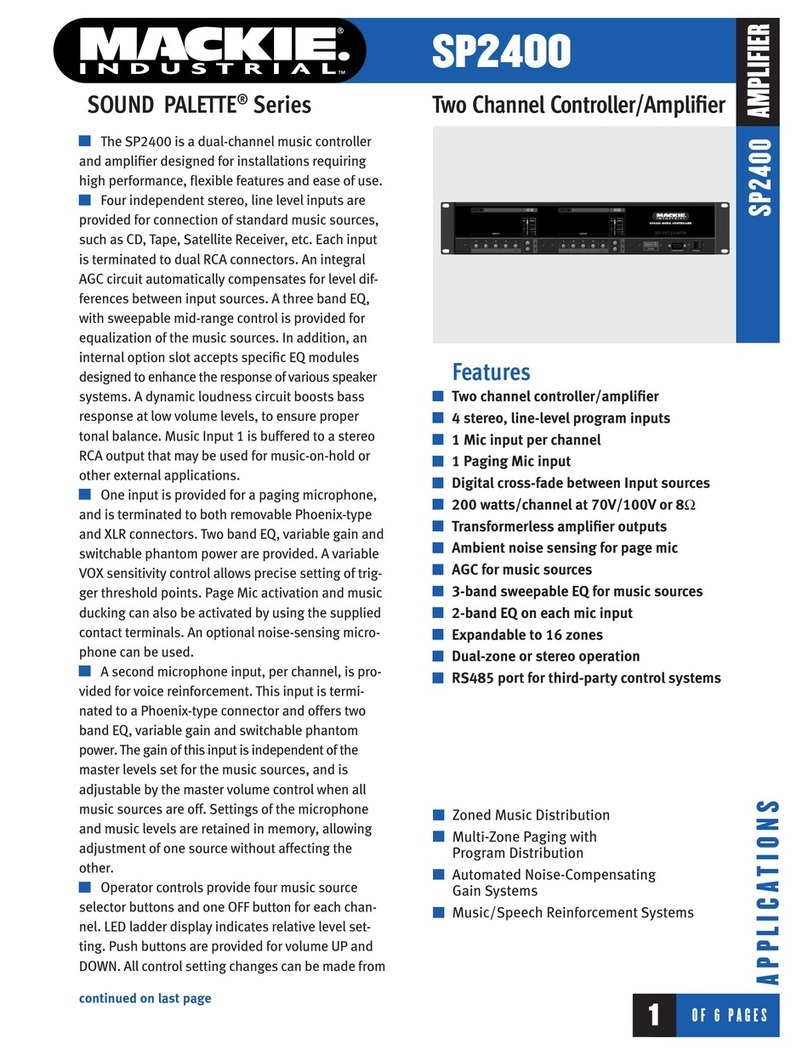Herron Audio M1 User manual

Solid State
Power Amplifier
M1
Solid State
Power Amplifier
Owner’s Manual
M1
Solid State
Power Amplifier

Herron Audio M1
Solid State Monaural Power Amplifier
Owner’s Manual
Please read the Owner’s Manual completely BEFORE operating the unit.
Please read the Owner’s Manual completely BEFORE operating the unit.
Herron Audio M1
Solid State Monaural Power Amplifier
one
The Amplifier
The M1 is a full complementary
symmetry bipolar implementa-
tion and contains no coupling
capacitors in the forward direc-
tion. It employs the latest
technology in wide band output
devices with enhanced low level
linearity. Proper stage-to-stage
impedance matching insures
extraordinarily low distortion
and unique successive stage to
output confluence provides a
seamless combination of
micro/nano-resolution from
forward stages and robust con-
trolled power and authority from
successive stages. This unified
current summation drive stage
network eliminates the crossover
notch problems common in
many solid state amplifier
designs. High idle current or
class A bias output stage opera-
tion is not necessary! The M1
runs cool under most listening
conditions and provides
a live presentation with none of
the hardness normally associated
with solid state amplifiers. The
output network of this amplifier
is resonance free and remains
stable even with a 1 micro-Farad
capacitor connected across the
output terminals. The M1 engen-
ders the fine resolution and
liquidity normally associated
with tube amplification plus the
power and bass control of solid
state. Individual voices remain
distinct and clear amidst the
crescendo full orchestra and
chorus. The sound of the M1 is
pure and true to the source.
It has the clarity, focus in time,
and natural sound inherent in
all Herron Audio products.
DC Response
The M1 incorporates automatic
low level d.c. offset cancellation
plus high level d.c. shutdown
speaker protection circuits. The
effects of continuous low level
d.c. at the input of the M1 will be
nulled out over time and higher
levels of d.c. at the input will
engage the shutdown protection.
Herron Audio M1 Power Amplifier
Table of Contents
1 The Amplifier
2 Break-in Time
3 Front Panel Features
4 Rear Panel Features
6 Installation
7 Troubleshooting
9 Specifications
© 2005 Herron Audio
Division of Herron Engineering, Inc.
12685 Dorsett Road
# 138
St. Louis, MO 63043
314.434.5416
314.434.6629 fax
http://www.herrronaudio.com

Owner’s Manual
Please read the Owner’s Manual completely BEFORE operating the unit.
Front Panel Features
Front Panel Features
three
The front panel has three indica-
tor lights for easily monitored
operational readiness of the unit.
The first light is the “power” indi-
cator. This indicates that power
has been turned on. The “voltage”
light indicates that the amplifier
circuitry has been activated.
Upon shutdown the amplifier
is deactivated at the same instant
that the output relay is opened.
This prevents contact wear and
contamination from arcing which
is common in conventional
designs. The approach used in the
M1 prolongs the life and sound
quality of the relay.
A blinking “voltage” light
indicates that there is d.c. pre-
sent at the input of the
amplifier. The blue “output”
light indicates that the output
relay is engaged and the M1 is
ready for listening. If the M1 is
overheated (78 degrees Centi-
grade), the “output” light and
the “voltage” light will turn off
(amplifier deactivated) until
the heat sink cools 10 degrees
Centigrade. Two red “over tem-
perature” LEDS will be visible
through the top of the unit. The
normal start-up sequence of the
unit is designed to run a
self check and accelerate the
warm up/break-in process.
Herron Audio M1 Power Amplifier
two
Important Note: Due to the ability of the M1 to amplify d.c.
for short periods of time, the d.c. speaker protection shutdown cir-
cuits may activate for a brief time shortly after the line stage preamp
or other input source device has been turned on. If d.c. persists at
the inputs of the M1 the output of the amplifier will remain off and
the voltage light will blink on and off until the d.c. is at a low
enough level for safe operation. This condition is normally tempo-
rary and lasts until the capacitors have fully charged in the input
device. The amplifier will then restart automatically. We generally
recommend that the front end equipment be started ahead of the
power amplifiers, although no harm will come from a d.c. protec-
tion shutdown sequence.
Break-in Time
Anytime the M1 has been shipped or transported for more than a few miles it is
highly recommended that the unit be re-broken-in. Completion of the break-in
process makes a significant improvement in the sound quality of the unit.
Break-in time after shipping is generally 72 hours of running with music.
The M1 has been equipped with an auto-break-in circuit that runs the bias of
the amplifier at an increased level just after the unit has been turned on. Opera-
tion of this feature in indicated by two orange lights (visible through the top of
the unit). The unit will remain in the auto-break-in mode until the heat sink
temperature has reached approximately 124 degrees Fahrenheit. The length of
time that this takes will vary from a few minutes to several minutes depending
on several variables including: room temperature, unit temperature, line volt-
age, etc.. The auto-break-in mode can be manually initiated or interrupted by
pushing the red button located near the red output connector on the back of
the unit. The use of the auto-break-in mode will help accelerate the break-in
process and warm up the amplifier during normal use.
N
OTE
: operation of the auto-break-in circuit may cause the amplifier to tem-
porarily trip off under certain operating conditions of voltage and temperature.

Owner’s Manual
Please read the Owner’s Manual completely BEFORE operating the unit.
five
Red Push Button
The red push button located
between the red output terminal
and the heat sink can be used to
initiate or interrupt the high bias
auto-break-in mode of the M1.
The auto-break-in mode is auto-
matically initiated when the
amplifier is first powered up and
will automatically shift to normal
bias mode when the heat sink
reaches approximately 124 degrees
Fahrenheit. Operation of the auto-
break-in mode is indicated by two
orange lights that are visible
through the top of the unit.
N
OTE
: Initiating the auto-break-in
mode when the amplifier is hot
may cause the unit to temporarily
trip off.
Heat Sink
The heat sink on the back panel
of the M1 is designed to dissipate
heat generated by the output sec-
tion of the amplifier. For best
performance and long life the
unit should be used in a well
ventilated area. Excessive heating
may occur under heavy load
conditions in a poorly ventilated
location and could cause the
unit to shut down.
Input Connector
The M1 has one gold-plated RCA
input connector. The RCA input
plugs (interconnect terminations)
should be inserted firmly into the
input jack while the unit is pow-
ered down. It is not recommended
that the unit be powered on with-
out an input connection.
Connection to the speaker binding post terminals
should only be made while the unit is powered down.
The RCA input plugs (interconnect terminations) should be
inserted firmly into the input jack while the unit is powered
down. It is not recommended that the unit be powered on
without an input connection.
Herron Audio M1 Power Amplifier
Rear Panel Features
Rear Panel Features
four
The rear panel was designed for flexibility and ease of access to
less frequently used functions. The high precision RCA input jack
and output connectors are gold plated to minimize signal degrading
corrosion.
Power Connection
An IEC power cord connector is
provided for attaching the Herron
Audio-provided power cord or
another chosen by the user.
Power Switch
When placed in the on position,
the unit is powered up. At power
up, the unit goes through a start-
up sequence and remains muted
until the output light comes on.
When the switch is moved to the
off position the unit is automati-
cally muted and powered down.
Output Terminals
The M1 has two gold-plated Tiff
speaker binding post terminals.
These terminals are labeled with
the designation “OUTPUTS” on
the rear panel of the unit.
The polarity is designated with
red and black insulating collars.
The red collar signifies the posi-
tive terminal. The M1 is non
inverting. Connection to the
speaker binding post terminals
should only be made while the
unit is powered down.

Owner’s Manual
Please read the Owner’s Manual completely BEFORE operating the unit.
Troubleshooting
Troubleshooting
seven
Symptom
1. The output light is on (blue) and there is no sound.
A. Check speaker terminations
B. Check the interconnect terminations at the M1 and at
the preamplifier.
C. Check the source equipment.
2. The power light is on, but the voltage light goes on and off
and the output light does not come on. No Sound.
A. Check input source for d.c. at its output. Note: It is not
uncommon for preamplifiers and other audio source
equipment to produce a d.c. offset for a short period of
time after being powered up. This condition will nor-
mally clear up after a few minutes. It is recommended
that the M1s be powered up after the preamplifier,
phono stage, CD player, etc. have been turned on.
3. The amplifier trips off while the output light and voltage
light periodically go out (the sound is interrupted) when
listening at high volume.
A. This condition occurs when the internal protection cir-
cuits detect an over-current condition.
4. The amplifier trips off and the output and voltage lights
turn off. This condition indicates that the output section of
the amplifier has over-heated (78 degrees centigrade). Make
sure that the unit is adequately ventilated. The unit will
Herron Audio M1 Power Amplifier
six
Placement
Although the M1 power amplifier
runs relatively cool, it is recom-
mended that these amplifiers are
used in an open area for best
operation and prolonged life.
Each M1 contains an oversized
toroid transformer wound in a con-
figuration designed for minimum
magnetic field radiation. It is rec-
ommended, however, that the M1s
be placed at least a few feet away
from sensitive front end equipment
such as a turntable or phono stage.
Power Connection
When possible, connect the same
power outlet used for the preamp,
phono stage, CD player, etc. This
configuration will minimize the
reactive currents from power line
RF that will be impinged on the
interconnect cables between the
audio equipment in the system.
Recommended Loading
We do not recommend using the
M1 with a 2 ohm load. As with all
audio amplifiers increasing the
load will increase the distortion
and defeat the purpose of having
a really clean amplifier such as the
M1. For this reason we did not
design the M1 to drive a 2 ohm
load to full power. The over-
current trip circuits will engage
under those operating conditions.
Speaker Cable
Optimum performance from the
M1 will be obtained only with
careful selection of the appropri-
ate cables from the amplifier to
the speakers. Minimum capaci-
tance and inductance is preferred
in order to avoid over-shoot and
ringing in the cables. Here, simple
high quality cable is of utmost
importance.
Installation
Installation

Owner’s Manual
Please read the Owner’s Manual completely BEFORE operating the unit.
M1 Technical Specifications
M1 Technical Specifications
nine
Configuration Single-channel (monaural)
Frequency response 20 to 20kHz +/-0.1dB
Output Power 150 Watts @ 8 ohms, 275 Watts @ 4 ohms
(measurements at 1 kHz)
Gain 24 dB
Input Impedance 220k Ohms
Absolute Polarity Non-inverting
Power Requirements 100, 120, 230, 240 VAC. 50/60 Hz.
Standard IEC power connector
Toroidal transformer taps internally selected
for appropriate voltage
Main(s) Fuse 120 VAC - MDL5
230 VAC - MDL3
Dimensions 19” wide ×4” high ×10.5” deep
Warranty 3 years, parts and labor
Manufactured by Herron Audio Division of Herron Engineering, Inc.
St. Louis, Missouri
Herron Audio M1 Power Amplifier
Troubleshooting—cont’d
Troubleshooting—cont’d
eight
turn back on automatically when the heat sink has cooled
to 68 degrees centigrade.
Two red LEDS (visible through the top cover) indicate an
even temperature condition.
5. The power light comes on but the voltage light never
comes on.
A. The M1 contains two AGC 6 amp internal rail fuses (F2
and F3) located on the p.c. board for circuit protection.
In the unlikely event of a failure of one or both of these
fuses, red indicator lights will be visible through the
vents in the top of the unit.
Table of contents
Other Herron Audio Amplifier manuals
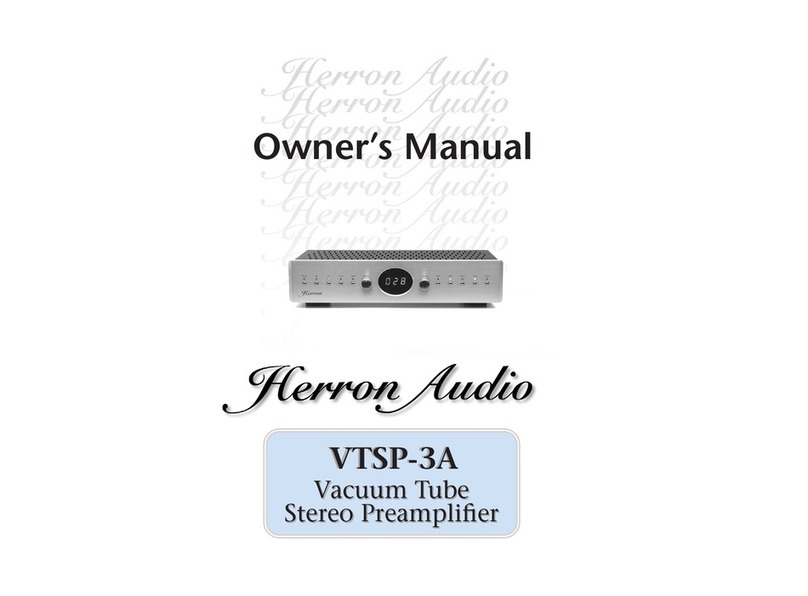
Herron Audio
Herron Audio VTSP-3A User manual
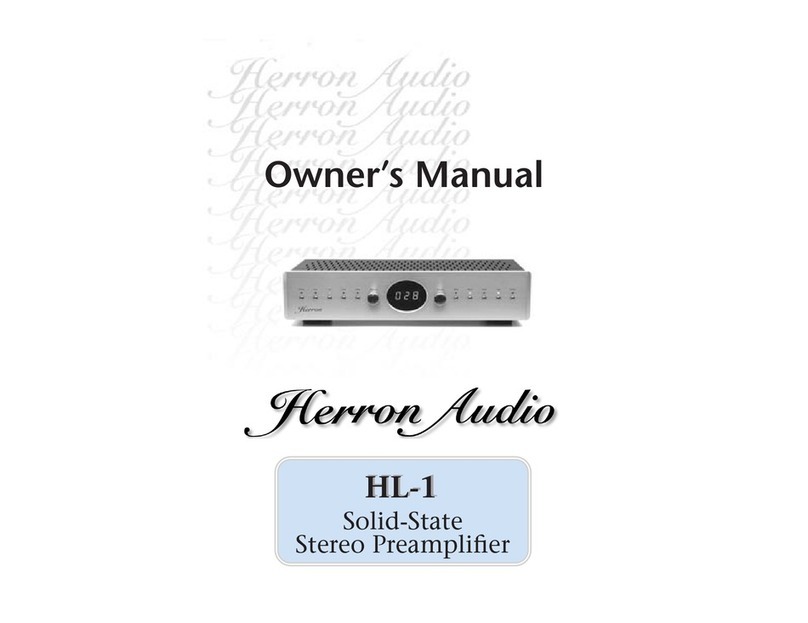
Herron Audio
Herron Audio HL-1 User manual
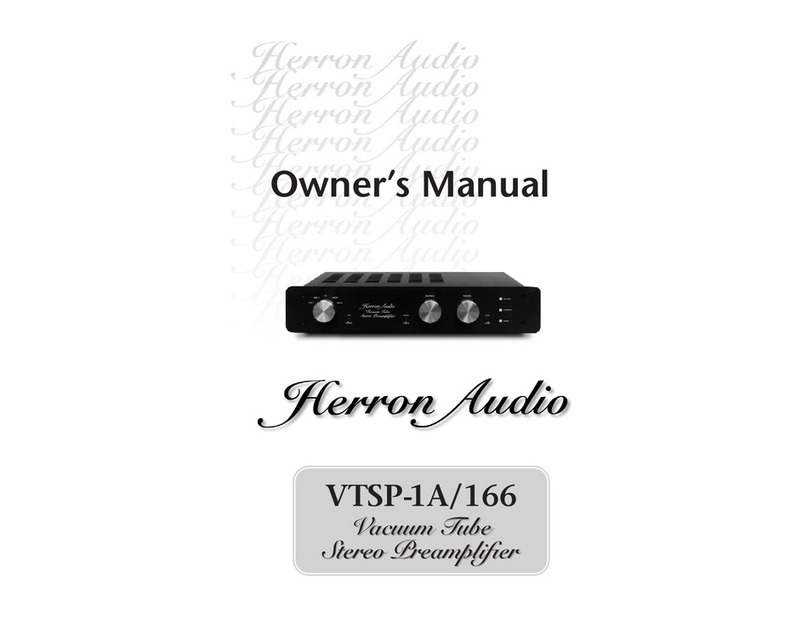
Herron Audio
Herron Audio VTSP-1A/166 User manual
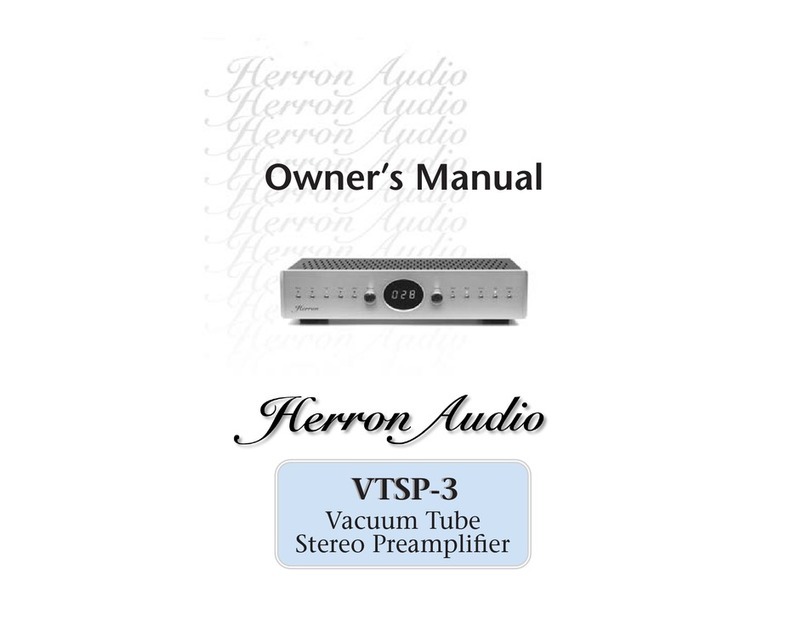
Herron Audio
Herron Audio VTSP-3 User manual
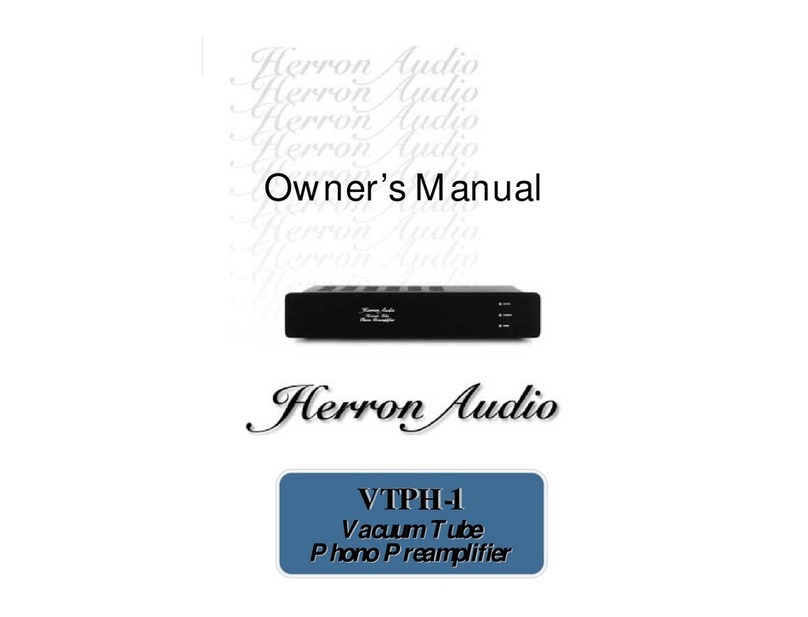
Herron Audio
Herron Audio VTPH-1 User manual

Herron Audio
Herron Audio VTSP-3A User manual
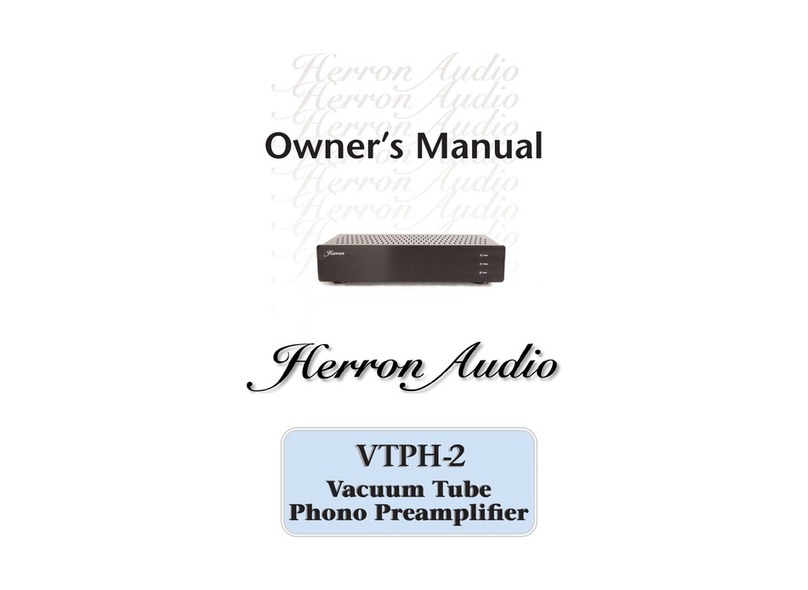
Herron Audio
Herron Audio VTPH-2 User manual

Herron Audio
Herron Audio VTPH-2 User manual
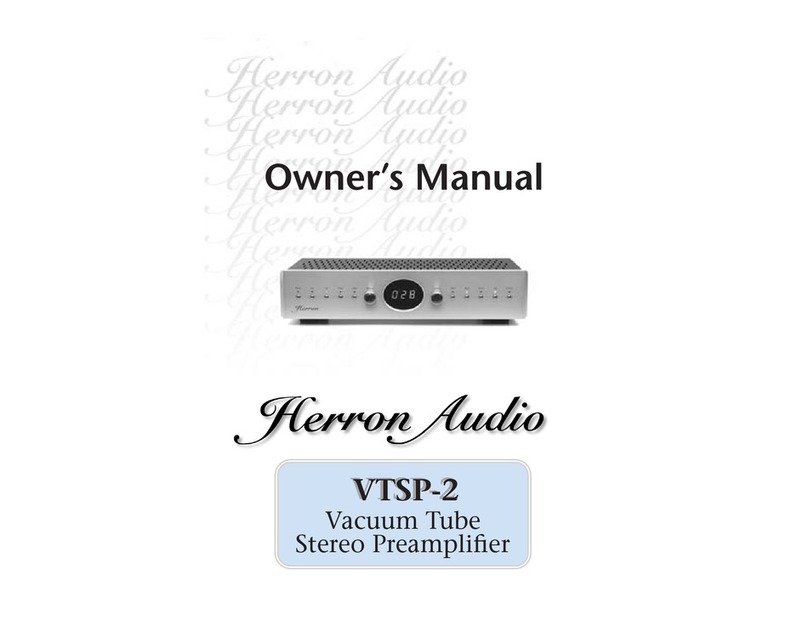
Herron Audio
Herron Audio VTSP-2 User manual
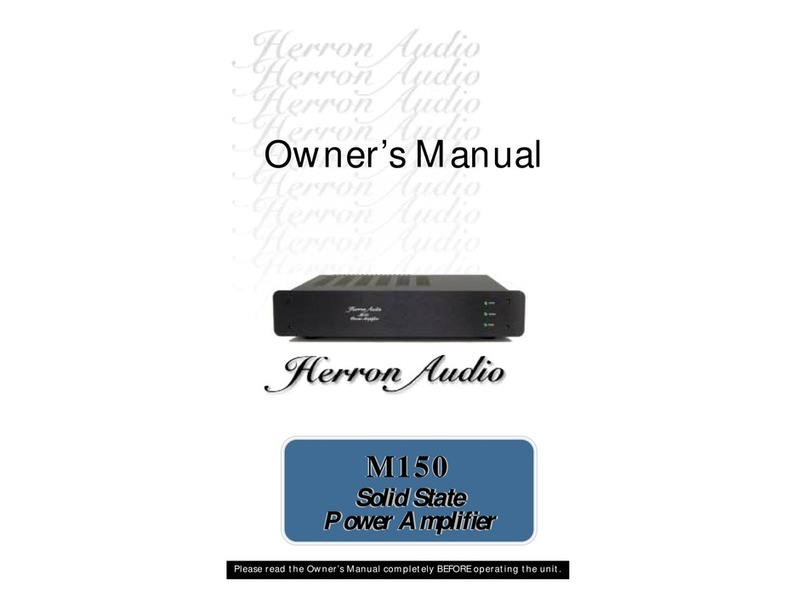
Herron Audio
Herron Audio M150 User manual
